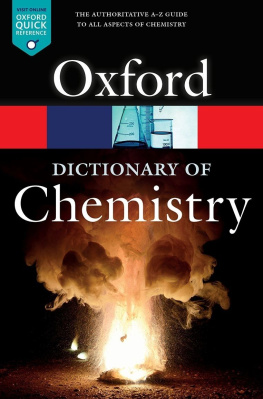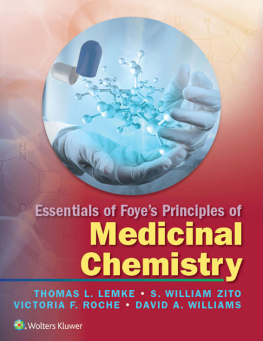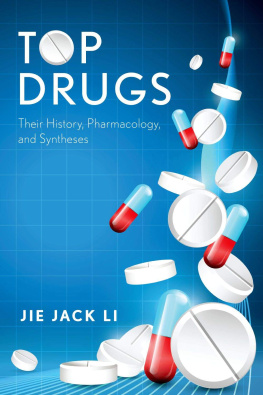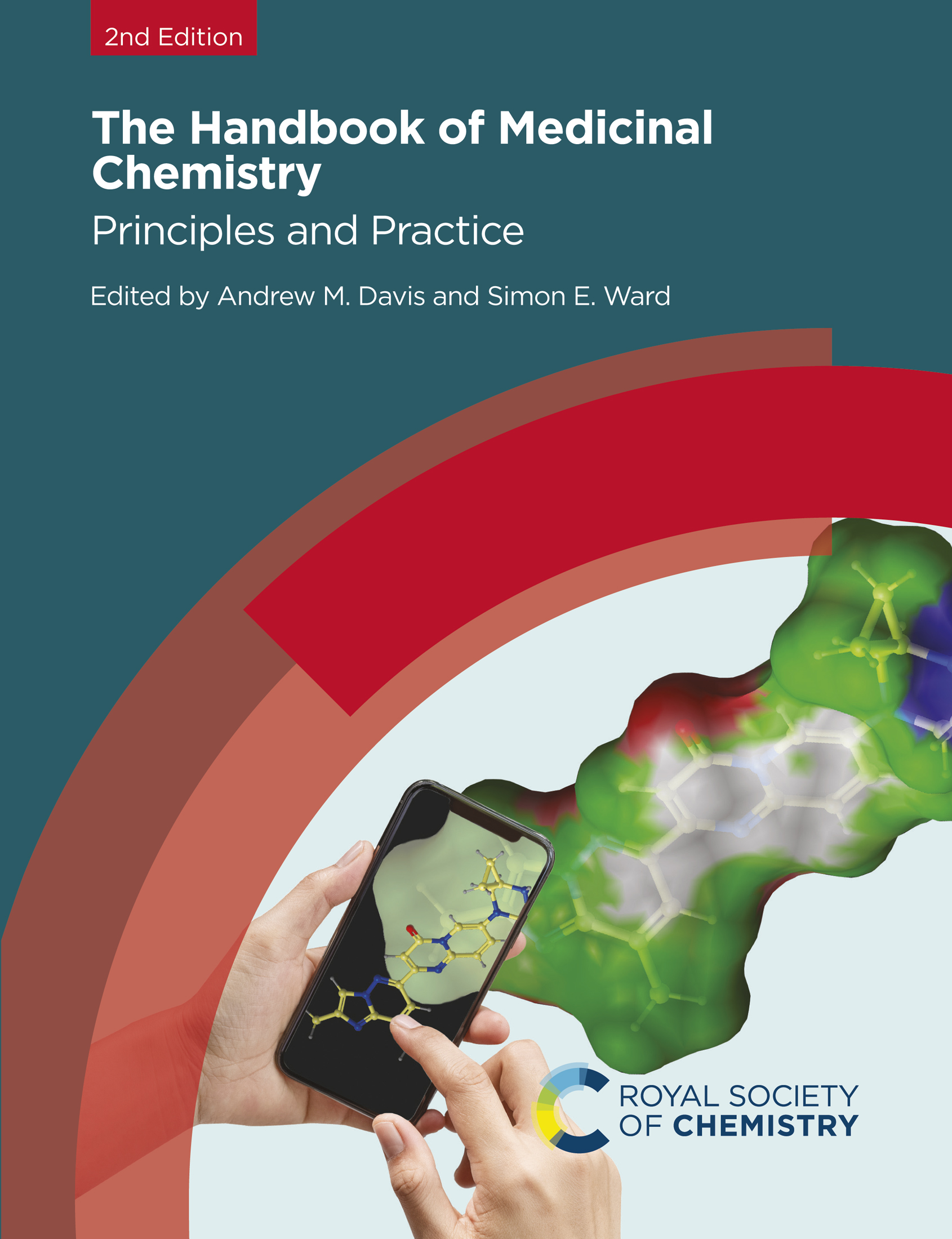Contents
The Handbook of Medicinal Chemistry
Principles and Practice
2nd Edition
The Handbook of Medicinal Chemistry
Principles and Practice
2nd Edition
Edited by
Simon E. Ward
Cardiff University, UK
Email:
and
Andrew M. Davis
AstraZeneca, Sweden
Email:
Print ISBN: 978-1-78801-898-2
EPUB ISBN: 978-1-83916-588-7
A catalogue record for this book is available from the British Library
The Royal Society of Chemistry 2023
All rights reserved
Apart from fair dealing for the purposes of research for non-commercial purposes or for private study, criticism or review, as permitted under the Copyright, Designs and Patents Act 1988 and the Copyright and Related Rights Regulations 2003, this publication may not be reproduced, stored or transmitted, in any form or by any means, without the prior permission in writing of The Royal Society of Chemistry or the copyright owner, or in the case of reproduction in accordance with the terms of licences issued by the Copyright Licensing Agency in the UK, or in accordance with the terms of the licences issued by the appropriate Reproduction Rights Organization outside the UK. Enquiries concerning reproduction outside the terms stated here should be sent to The Royal Society of Chemistry at the address printed on this page.
Whilst this material has been produced with all due care, The Royal Society of Chemistry cannot be held responsible or liable for its accuracy and completeness, nor for any consequences arising from any errors or the use of the information contained in this publication. The publication of advertisements does not constitute any endorsement by The Royal Society of Chemistry or Authors of any products advertised. The views and opinions advanced by contributors do not necessarily reflect those of The Royal Society of Chemistry which shall not be liable for any resulting loss or damage arising as a result of reliance upon this material.
The Royal Society of Chemistry is a charity, registered in England and Wales, Number 207890, and a company incorporated in England by Royal Charter (Registered No. RC000524), registered office: Burlington House, Piccadilly, London W1J 0BA, UK, Telephone: +44 (0) 20 7437 8656.
Visit our website at www.rsc.org/books
Printed in the United Kingdom by CPI Group (UK) Ltd, Croydon, CR0 4YY, UK
Foreword to the 2nd Edition
I am very happy to have been given the opportunity to write this Foreword to the latest edition of The Handbook of Medicinal Chemistry. This science whose practice we all share has a long history and looks to have a lengthy future as well but just as it does not resemble its beginning very much by this point, its later form will surely be quite different from what we see now. Large changes are coming. Well of course they are, you may well think, there are always large changes coming. What's so different now? What makes this Foreword different? Perhaps a bit of history will help make the case for that statement.
Targets and Drugs
My career as a medicinal chemist began in 1989, in a central nervous system research group. Naturally, I did not know enough to be terrified of the problems that were set before us, which were diseases such as schizophrenia and Alzheimer's. (It will immediately be noted, for example, that both of those are very much still with us and still in need of pharmacological aid). I soon learned, though, that my colleagues in the biology labs were quite excited about the G-protein coupled receptors that we had targeted in both areas, as new technology was displacing the tissue assays that had been in use for many years. It was, for example, farewell to the rabbit trachea and the rat vas deferens in muscarinic receptor characterization, and a look at the older literature will clear up any suspicions that I might be inventing those. Instead, we welcomed the cloned receptor subtype membrane-binding assays, which we felt would surely clear up many of our difficulties once we all got our bearings.
This switch to such individual targets with assays enabled by molecular biology had been taking place throughout the 1980s, with the late-1970s success of captopril That is, one was not to assume that these were necessarily defined molecular entities with real structures, but rather just useful mental models or a sort of shorthand to categorize the various mysterious classes of drug action. Even among those researchers who took receptors to have physical reality, it was unclear if they were proteins, complex carbohydrates, or who knew what. And as for how they might work? That was even more mysterious.
Receptors turned out to be real molecular species, of course in fact, they were proteins that could be cloned and expressed once we knew how to do such things. The same went for enzymes, whose proteinaceous nature had become clear much earlier, but whose production and purification were likewise changed forever by molecular biology techniques. And thus medicinal chemistry went through one of its revolutions, with target-based drug discovery becoming the unquestioned default mode of the field. It still is. Target-agnostic phenotypic screening went into eclipse for a while, but even with its revivals over the years, the first thing that people will try to do with an interesting phenotypic hit is to try to identify its specific target. And that's done partly so that the protein can then be expressed and turned into the subject of the non-phenotypic screening assay it would have been from the beginning, had anyone but known to look at it.
This is the world that readers of this new volume have been living in (as have I!) There's no doubt that it's been good to us. Whole classes of actionable targets have opened up over the years: enzymes such as the proteases, hydrolases, kinases, and phosphodiesterases, all ready to be inhibited, and also the receptors and ion channels to be addressed in all their profusion: agonists and antagonists, full and partial and inverse, all waiting to be discovered and exploited. A solid history of modern medicinal chemistry could be written from the perspective of watching these territories being mapped out and settled.
All of them attracted some doubters at first. With the profusion of kinase-targeting drugs that we have now, it can be difficult to remember that some very intelligent people wondered at one time whether a selective kinase inhibitor was even possible. After all, wouldn't you just hit every other ATP-binding site in the whole cell? Sometimes the doubters had a point, though: the nuclear receptors have had some striking successes as drug targets, but many of those came before we even understood them very well, and not so many have arrived since. Epigenetic enzymes went through a great period of enthusiasm too, but it's been a difficult field to make progress in. No doubt many readers can provide other examples from their own experience.
For a while, it was difficult to imagine that target-based drug discovery had any real limits, but anyone who took the time to think about it knew that it must. The number of pathways in living cells is large, but most certainly finite as is the number of proteins, and of course the number of genes coding for them. Indeed, one of the most direct reminders that there would eventually be an end to it all was provided by the Human Genome Project. The speculative frenzy around human sequencing in that era was driven by the fear that unless you reached into your pocket immediately, other people (and not you, you cheapskate) would end up owning the rights to all of those targets and all of those proteins. Patents were being filed at a ridiculous pace, many of them doubtless overlapping in what promised to become an epic tangle during prosecution. The signs were clear: the great prairie of target space had at one time stretched almost unbroken to the horizon, but now there was dust flying everywhere as fence posts were pounded in and barbed wire was hurriedly strung up.






